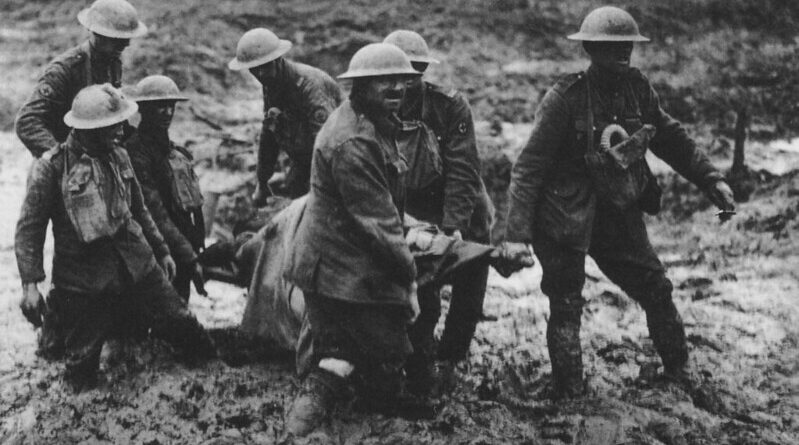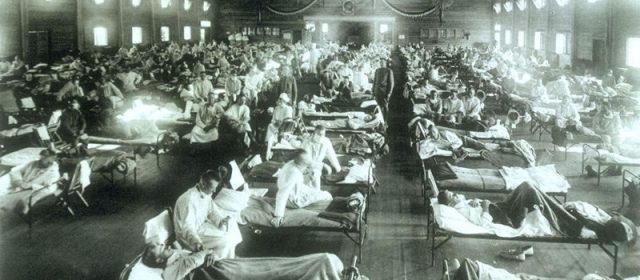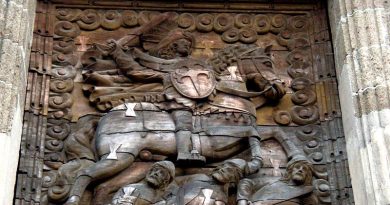What Caused World War I?
World War I, the Great War, the War to End all Wars, no matter what you call it, it was a game changer. Lasting from 1914 to 1918, this war was the first to encompass almost every major power from across the globe. The Central Powers of Austria-Hungary, Germany, and the dying Ottoman Empire fought against the Allied Powers of France, Great Britain, Russia, and eventually the United States, all over a desire for power and territory.
World War I also saw a clash between the old style of 19th century warfare and newly developed 20thcentury technologies that would change the face of war forever. In the early years of the war, soldiers on each side fought ineffective battles and suffered huge losses as both tried to test out new methods and weapons. WWI saw the introduction of trenches, where millions of men on each side attempted to protect themselves in huge, sometimes skilfully and other times quite crude, hideouts. Also new to the war were fighter planes, tanks, machine guns, and poison gas, all technologies that were never fully finessed until years after the war ended.

By the end of the war, both sides had lost over 37 million soldiers and civilians. Official “peace” was reached after the signing of the Treaty of Versailles, negotiated and written up by the winning Allied Powers. Unfortunately however, the Central Powers, more specifically Germany, suffered major consequences, and ended up creating a pretext for World War II. As the World War I centenary approaches, we take a look back at the history of the war, and what made it as terrible as it was.
What Caused World War I?
Even as we approach its 100th anniversary, there is still plenty of debate as to what actually caused World War I. In  reality, so many factors all piled up in a surprisingly long amount of time, with the assassination of Austria-Hungary’s Archduke Franz Ferdinandin Sarajevo finally sparking as definitive of a beginning as we’ll ever get. On June 28th, 1914, while on a formal visit to the capital of Bosnia, Sarajevo, Franz Ferdinand and his wife were shot by Gavrilo Princip, a member of a Bosnian terrorist group called the Black Hand.
reality, so many factors all piled up in a surprisingly long amount of time, with the assassination of Austria-Hungary’s Archduke Franz Ferdinandin Sarajevo finally sparking as definitive of a beginning as we’ll ever get. On June 28th, 1914, while on a formal visit to the capital of Bosnia, Sarajevo, Franz Ferdinand and his wife were shot by Gavrilo Princip, a member of a Bosnian terrorist group called the Black Hand.
Proponents of Serbia were upset that Austria-Hungary had annexed both Bosnia and Herzegovina, and hoped that the assassination would stall any further reforms. Franz Joseph, emperor of Austria-Hungary and uncle of Franz Ferdinand, wasn’t too fond of his nephew, but nevertheless saw the assassination as an opportunity to further exert some authority. He presented Serbia with an ultimatum made up of a long list of demands, assuming that Serbia would not accept it. However, Serbia accepted everything in the ultimatum, albeit a few clauses, but that was enough to prompt Franz Joseph to declare war against Serbia on July 28th 1914.
If you remember from your history lessons as a young student, Ferdinand’s death probably sticks out to you as the main and only cause of the war. However, as we now know, much of what we learn in school isn’t always the full story. By the time of the assassination, many of Europe’s main powers had already entangled themselves in a huge mess of alliances and agreements.
The Main Players
And here is how it all panned out. Austria-Hungary and Serbia were now at war. Russia had signed a treaty years earlier stating that it would defend Serbia and thus announced mobilisation of its army. Germany, who was already allied with Austria-Hungary, saw this mobilisation as an act of offense, and thus declared war against Russia on August 1st. France inevitably became involved as well, as it was a friend of Russia, and was now at war with Germany and Austria-Hungary.
Germany then invaded Belgium, an internationally neutral site, and that was how Britain found itself involved. Britain had signed a treaty with France, basically giving itself a moral obligation to defend its sister country, but its main reason for entering had to do with Belgium. Britain was a part of a 75 year old treaty which involved defending Belgium should a situation like this arise. At this point, the United States had no intention of getting involved. The president at the time, Woodrow Wilson, declared absolute neutrality, which lasted until 1917 for reasons we’ll get to later.
There were also a number of smaller players that got involved. Japan ended up declaring war on Germany in accordance with a military treaty with Britain. Italy was allies with both Germany and Austria-Hungary, but avoided entering into the war for as long as possible. Then came Britain’s numerous colonies and territories, some of which included India, Canada, New Zealand, Australia, and the Union of South Africa. Complicated, right? By the time war was in full swing, here’s how things looked.
And So It Begins…
Unsurprisingly, many of the main European powers heading into war already had plans in mind. With similar goals of expansion and a desire become the strongest, most powerful nations in the world, the major leaders in every country knew that war was inevitable; World War I just happened to give them their long awaited outlet. Here are just a few of the major battle plans created at the outset of the war.
Schlieffen Plan
The German Schlieffen Plan, named after and created by Count Alfred von Schlieffen, outlined plans for a war on both the eastern and western fronts. To the east was France, which Germany planned on invading, and to the west was Russia, who was then known as a vast and unorganized country with and unless supply of soldiers.
Schlieffen was determined to crush France within six weeks, taking them out of the war as quickly as possible. In order to do so, he committed almost the entirety of the German army to the western front, in the hopes of overwhelming the French and taking control of Paris. Back on the eastern front, Schlieffen wasn’t too worried. Because of Russia’s lacking leadership and supplies, Schlieffen somewhat correctly assumed that Russia still wouldn’t be mobilised by the time the Germans were finished with France. This lead to a smaller army being placed on the eastern front, just enough to hold off the few attacks Russia could pull together.
order to do so, he committed almost the entirety of the German army to the western front, in the hopes of overwhelming the French and taking control of Paris. Back on the eastern front, Schlieffen wasn’t too worried. Because of Russia’s lacking leadership and supplies, Schlieffen somewhat correctly assumed that Russia still wouldn’t be mobilised by the time the Germans were finished with France. This lead to a smaller army being placed on the eastern front, just enough to hold off the few attacks Russia could pull together.
Working as quickly as possible, German troops attempted to invade France through neutral Belgium, working through Alsace-Lorraine all the way to Paris. While doing so, they’d keep a small army right at the Franco-German border to stall any advances into Germany while the larger army worked towards Paris and built up their numbers inside of France. Luckily for them, this part of the plan succeeded. Though the German’s ended up retreating, ultimately because of poor communication and too tight of a time constraint, they were so far into French territory that they weren’t at too much of a loss.
Plan XVII
France’s plan for the war had the main goal of winning back their old territory of Alsace-Lorraine. Germany had been occupying the territory since 1871 and the French hoped that full on offensive attack would push the Germans out for good. Unfortunately, they didn’t take into account an invasion of Belgium. The assumption was that the treaty between Britain and Belgium, guaranteeing neutrality of the area, was enough to keep Germans away but in reality, Germany regarded the treaty as a measly “scrap of paper.” By the time they realized their error and sent troops towards Belgium, they were lacking in proper strength and planning.
Overall, the outset of the war for France proved to be quite a debacle, as the Germans successfully repelled the French and kept Alsace-Lorraine. From this point, France was put on a full on defence.
The First Moves
War plans finally began to spring into action as Germany made its way towards France and through Belgium. Though they expected to gain control of France quickly, they underestimated civilian snipers who positioned themselves around cities, shooting from hidden places. In response, the Germans began burning down villages, executing everyone, from men to women and children. Eventually in late August, Brussels, the capital of Belgium, did fall, all while more German troops placed themselves along France’s eastern front, all according to the Schlieffen Plan.
Unfortunately for Germany, that’s as successful as their plan would ever get. On August 17th, Russian troops were able to pull their act together and cross into Germany through East Prussia. The small amount of reserve German troops on that side of the border wasn’t enough, and Russia was able to move in quite easily. General Maximilian con Prittwitz, German commander at the time, found himself overwhelmed, panicked, and immediately tried to retreat. Higher ranking military leaders decided to replace Prittwitz and choose General Paul von Hindenburg, a man who would become a key figure as the war progressed.
During the battles of Tannenburg and Mansurian Lakes, Hindenburg pushed back and basically slaughtered the Russian troops, decreasing the Russian militia by approximately 300,000 in less than one month. Austria-Hungary, on the other hand, wasn’t doing as well as its ally Germany. On August 18th, another Russian army invaded the Austro-Hungarian territory of Galicia but the Austro-Hungarian general miscalculated where exactly the Russian troops would be. What resulted was a roundabout chase, with both armies trying to track each other down all while Russian soldiers pushed deeper past their enemy’s borders.
In this first month of war alone, actions taken by Germany and Russia set precedence for the rest of the war. As plans began to fail and as generals from each country became more risky with their moves, the major powers soon realized that this war wasn’t going to be as quick as they thought.
Germany And France
The Battle of Mons
Situated along the Franco-Belgian border, the town of Mons was the site of the first joint effort between France and Britain against Germany. Unfortunately for the Allied forces, German long-range artillery proved fatal, and they were forced to retreat for two whole weeks. By this time, German troops were able to advance all the way to right outside of Paris, but not without diligent attempts from Britain and France to stall them.
The Battle of the Marne
Eventually, British and French attacks wore down the Germans and reinforcements from Paris allowed them to halt the Germans on September 4th. The next day, a huge five day battle began, with over a million troops fighting on each side, with the Allies determined to protect Paris. As the battle wore on, German armies began to split and Allies used this to their advantage, using taxis to fill in the gap and prevent the armies from regrouping. Eventually, German’s were pushed back all the way to the Aisne River. Though they lost their ideal position, they were able to claim a good position at the river, leading to both a deadlock and the important beginning of the western front. It was at this point that they famed Schlieffen Plan had finally and fully failed.
The War At Sea
Battles on the sea, though they existed, were not of significant importance. Major powers did desire control of certain seas and waterways, building up their naval fleets to do so, but the main players at this point, Britain and Germany, ended up battling over control of vital trading routes rather than capturing brand new territories. However, WWI did see the rise of new aquatic weapons, the submarine, torpedo, and sea mine. Germany, almost by accident, discovered the efficiency of submarines, equipping them with torpedoes and blasting away over 2000 British soldiers in September and October of 1914 alone. Britain, on the other hand, saw the use of submarines and even mines as “cowardly,” and thus discouraged their use and continued to fight with their Royal Navy instead.
The War In The Skies
WW1 saw the start of air warfare. At the brink of war, the airplane had only been around for ten or so years and people had little faith in its practical uses. Their scepticism was understandable; at this point, planes were slow and could barely lift more than one passenger, two if you were lucky. However, war strategists thought that planes could be quite useful for spying on enemies, and as a result, the reconnaissance plane was created. These planes would fly over enemy ground, with one passenger photographing troop positions and relaying the information to strategists. For many battles, including the Battle of Mons and the Battle of the Marne, these planes proved to be crucial.
 Now that spies were in the air, strategists now saw the need for a way to stop them. They soon realized that shooting the planes from the ground was ineffective and this lead to the creation of fighter planes. The first fighter planes were quite useless; pilots attempted to attack each other down with pistols, grenades, and even bricks.Eventually, a Dutch aircraftsman by the name of Anton Fokker, saw potential in the use of machine guns, and thus came up with the “interrupter gear,” which would synchronize the gun with the moving propeller, allowing for swift and continuous attacks. Pilots Max Immelmann and Oswald Boelcke became the first pilots to use this method, shooting down another aircraft on August 1st, 1915 and it wasn’t until a year later that British and French designers followed suit.
Now that spies were in the air, strategists now saw the need for a way to stop them. They soon realized that shooting the planes from the ground was ineffective and this lead to the creation of fighter planes. The first fighter planes were quite useless; pilots attempted to attack each other down with pistols, grenades, and even bricks.Eventually, a Dutch aircraftsman by the name of Anton Fokker, saw potential in the use of machine guns, and thus came up with the “interrupter gear,” which would synchronize the gun with the moving propeller, allowing for swift and continuous attacks. Pilots Max Immelmann and Oswald Boelcke became the first pilots to use this method, shooting down another aircraft on August 1st, 1915 and it wasn’t until a year later that British and French designers followed suit.
In reality, air warfare wasn’t as exciting and glamorous as war movies tend to make it out. Most pilots went up with only about five hours of training, which inevitably lead to many errors. Often, because of a lack of proper planning, pilots were defeated by simple things, like bad weather, lack of experience, and technical issues. Sometimes, pilots would even just stray off course and find themselves lost and on enemy lines, only to die after running out of fuel. You might be asking, weren’t parachutes already around by then? They were, but some countries, like Britain, didn’t allow their pilots to carry them, as they were seen as cowardly. Finally, the last air weapons put into use were bombs and zeppelins.
Zeppelins, used mainly by the Germans, were large, delicate airships, capable of carrying large amounts of cargo and explosives. Bombs were dropped over London and Paris and zeppelins began to be seen as hugely efficient, up until 1915. Eventually however, as fighter planes developed more, zeppelins became very vulnerable, as just one spark from a shot was enough to start a fire and destroy an entire ship.
A War Of Attrition
With WWI in full swing, the major powers found themselves fighting to no end without any sort of progress on either side. Italy, the indecisive one of the bunch, eventually decided that it was in its best interest to fight on the side of the Allies, quietly stepping out of its Triple Alliance with Austria-Hungary and Germany which had been in place since 1882. After solidifying its position, Italy signed the London Pact and declared war on Austria-Hungary on May 23, 1915. Eventually Austria-Hungary and Italy found themselves in a stalemate along the Isonzo River. Both suffered huge losses over the course of two and a half years but neither actually accomplished anything by the stalemate’s end in October 1917.
The Battle of Verdun
While Austria-Hungary and Italy were busy making no progress, one of the most significant and longest battles of WWI took place in the town of Verdun in France. German troops attacked the town, hoping to drain the supply of Allied forces and it was during this war that both sides heavily employed the use of poison gas. After ten whole months, despite various advancements on both sides, the fighting finally stopped but both were exactly

where they started at the beginning of the battle, now with650,000 less soldiers.
The Battle of the Somme
Known as one of the bloodiest battles in all of history, this battle started on July 1st, 1916, while the Battle of Verdun continued miles away. The amount of firing that took place on the river Somme, in addition to the sheer number of soldiers was so much that people in southern England could hear it. The battle was yet another example of losing many over little to no territorial gain, and was a sad example of the futility of trench warfare.
As 1916 approached, the midpoint of the war saw almost all war fronts at stalemates. All across the battlefields, hundreds of thousands of troops found themselves stuck in the trenches, constantly gaining and losing the same territories. Military leaders continued to use their same, failing strategies, merely to see which country could hold out longer.
Americans enter the war
 Throughout the beginning of Woodrow Wilson’s presidency, America remained isolated from the war across the seas, and when Wilson was re-elected, he promised to continue this isolation and keep Americans safe. The war dragged on, with battles leaving countries in ruin as millions of civilians and soldiers died, with no end for the war in sight. Wilson decided to begin a series of talks to bring about a resolution.
Throughout the beginning of Woodrow Wilson’s presidency, America remained isolated from the war across the seas, and when Wilson was re-elected, he promised to continue this isolation and keep Americans safe. The war dragged on, with battles leaving countries in ruin as millions of civilians and soldiers died, with no end for the war in sight. Wilson decided to begin a series of talks to bring about a resolution.
At first, things were looking hopeful; Germany recommended starting peace negotiations immediately but France decided to respond by launching another attack on Verdun and Britain was quick to also reject Wilson. With the negative response from Britain and France, German decided to go all out against the Allies, resuming unrestricted submarine warfare on February 1st 1917, focusing mainly on American and Canadian ships supplying the Allies and sinking all ships they deemed suspicious.
The Housatonic, an American ship carrying cargo, was the first to fall victim to the new warfare, and on that same day, Wilson decided to break off all relations with Germany, a move that greatly influenced America’s eventual involvement in the war.
The Zimmermann Telegram
The famed Zimmermann Telegram was probably the most important factor in bolstering American support for involvement in the war. In February 1917, the British intercepted a German telegram from Alfred Zimmermann, German foreign minister at the time, to an ambassador in Mexico. In the telegram were plans to promise aid to Mexico in reconquering their old territories that were now owned by the United States. A month later, the telegram was posted everywhere on the front pages of newspapers in America and public opinion immediately shifted towards accepting war.
Finally and inevitably, Congress declared war on Germany on April 6th 1917, and the transport of American soldiers across the sea began. Throughout the middle of 1917, US soldiers poured into Britain and France and fought under the leadership of General John J. Pershing.
Wilson’s Fourteen Points
In a speech to the U.S. Congress on January 8th, 1918, Wilson outlined fourteen detailed points he believed were necessary if peace was to be reached. Some points were basic, involving the departure of German troops from territories that were not their own, in addition to the elimination of economic barriers. His final and most memorable point was the establishment of a “general association” of the world’s countries, where each would have equal say, regardless of strength or numbers.
A Final End
By this time, Russia had exited the war. Russian civilians were unhappy with the amount of losses brought about over the past years; almost five million soldiers and civilians had perished and the country was in complete shambles. Eventually, the civil war within Russia would take place, causing even more negative consequences for the country. For the Allies, Russia’s exit meant that all of the Germans fighting on the eastern front would now move to the western one, where the French and British were fighting. The US troops proved to be the only hope, but they weren’t to arrive until much later.
For the time being, Germany enjoyed their increased supply of soldiers. At the same time, the Allied forces also felt a sense of renewed hope, as U.S. troops began to pour in. Both sides launched full offensive attacks, with Germany losing numerous battles and eventually falling back. At the same time, influenza broke out and killed tons of soldiers on both sides. Finally, as all countries continued to deteriorate, the governments of Austria-Hungary and Germany fall into chaos as multiple groups within the countries rebelled from within the military. Finally, when late 1918 arrived, it was evident that the Central Powers had lost. Eventually, each member signed armistice agreements, with Germany signing the last one on November 11th, 1918. Aside from ending the war, the agreements also forced Austria-Hungary to separate into smaller countries. Germany, on the other hand, received a harsher punishment, which included a huge loss of territory, limits on military development, and immense economic reparations.
What Did We Learn?
In reality, not much! Many historians note that World War I merely planted the seed for World War II. The Treaty of Versailles, which ended the war officially, put all blame on Germany, humiliating the nation and forced it to bear the huge financial burdens of the war. Though Germany did not pay the entirety of the unreasonable amount of money, it lost almost all financial stability and ultimately, radical groups, notably the Nazis, were able to gain support by exploiting the humiliation felt all across the nation.
Useful Links
For a quick summary of World War I, check out this video.
To find out what events are taking place in your area, visit the First World War Centenary website.







